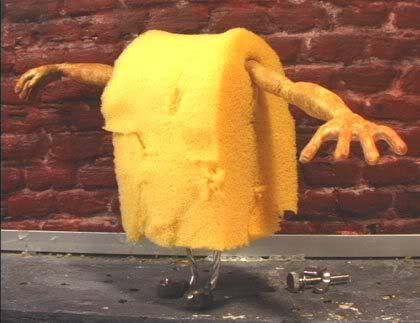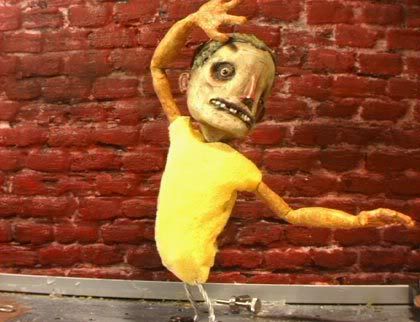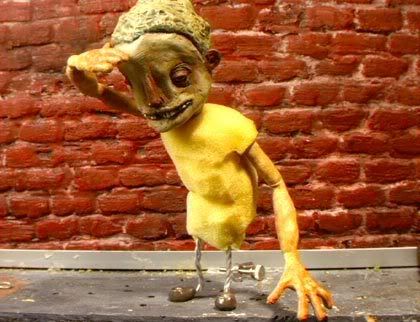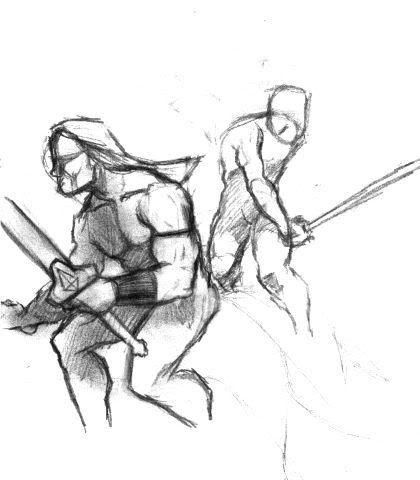I was going to answer this in the comments box, but decided to move it here. I'll begin with a quote from my last post and a response to it:
"In fact, they're basically terrified of attempting to make a puppet walk. They rarely do it, and prefer to have them glide about on wheels, like Gilgamesh on his tricycle or the women in the tailor's shop in Crocodiles, because it imparts a nice smooth elegance. The few times a puppet did walk they would inevitably laugh embarrasedly and comment on how "ropey" it is, and how much they hate doing it."
To which Michael responded (quite rightly):
"I think the phrase "we had a horror of" has been slightly misinterpreted - I understood it to mean that they have a strong aesthetic objection to something, not that they found it too technically difficult.
I mean, if they wanted to make things easy for themselves, they wouldn't have built the Street of Crocodiles set out of multiple reflective glass panels and buried everything under an inch-thick layer of dust, would they?"
Yes, I'm not entirely sure what they meant by that remark, I hope I didn't mangle it too badly! "We had a horror of" could mean they were afraid of it or that they had a hard time with it (or possibly something different?). I definitely got the impression they feel their walk animation is substandard and that they don't like to do it if they can find a way around it. Walks are one of the hardest things to do well, and they mentioned that at the time there were no books (and no websites!) on how to do puppet animation, and I believe most people who were doing it either learned from more experienced animators (which they didn't have access to as far as I know) or figured it out for themselves through trial and error. It's very appropos of their artistic sensibilities that they chose to forego walks (the stock in trade for most stop motion animators, on which a character's personality is usually based, or rather through which it's reflected) and flying shots and the like, and instead got the camera in close and made such scenes obsolete. And in doing so they give the viewers something to mull over - "what do the wheeled women represent?" etc. Brilliant! This kind of creative problem solving (which is a hallmark of their style) is exactly what I was trying to get at long ago in a thread called Things that work well (and things that don't) - the idea that " If it is hard to do in animation, maybe it's something that isn't natural to it. For example, if I need a character to throw something, rather than make a flying rig and get it in one shot, I will have him draw back his arm in an obvious winding-up gesture, and do a quick pan to the target area, where we see the object (formerly in his hand) hitting the ground or whatever. It is a way of using the entirety of the film technique rather than focusing on the effects".
The thread didn't really go the way I hoped it would, but instead it turned into my introduction to Eastern European stopmotion by the old masters like Trnka and Pojar. One of those life-altering moments that reverbrate like a gongstrike through the rest of your life.
The last special feature is an interview taped in some kind of doll museum and conducted by a French guy who really struggles with english. I couldn't understand all the questions, but some of the ones I did just made me say "Huh?!?!?" I don't remember just now what they were, but it seemed like he just didn't have a grasp of what the Bros are about. And it seemed like they had a hard time understanding him too, or possibly they feigned it to their advantage. It was amazing to watch... this guy would ask some lame question and in typical Quay fashion they'd stand thinking for a minute or two and one would start muttering almost randomly, and it seemed to me like they pretty much ignored the questions and just kept elaborating on thier own fascination with puppets. And it's a trip to see the way they talk... they're definitely intoverts and they stumble for words, sometimes they seem to be very forgetful or lost, and the one speaking will just trail off, and suddenly the other one will pick up, as if they share thoughts. It's uncanny really.
But the reason I brought this up is to talk a bit about their ideas on the puppet. They kept talking about liberating them, about how sad it is to look around in the museaum and see all these cutesy little babydolls and little girly dolls dressed in their victorian finery and all they ever do is just sit there on shelves gathering dust. I'm trying to paraphrase here, and probably messing it all up - hey, I sat through a lot of Quay last night! The details escape me. But they said something along the lines of feeling sorry for the puppets (meaning dolls - they seem to use the terms interchangeably) - like children who have to sit around all dressed up formally all the time and never get to demonstrate their inner life... that unique strangeness that dolls and puppets have as objects rather than as imitations of people, and they wanted to do something almost pornographic with them just to break them free. To give them a pathology. Pathological puppets! That pretty much describes what they do - they focus in neurotically on individual gestures, meaningless repetitive twitches and the like, revealing mental or physical abberations. What a totally different approach from the usual! They said they love Trnka and Starevitch, but they felt the films were shot in a very static manner, without any use of cinematic language (and yes Shelley, they actually used that phrase!). So they wanted to bring the full complement of cinematography to bear in their little world. I repeatedly got the impression that they were neophytes learning as they went - they said a lot of their early reels would come back improperly exposed or somehow messed up, and they gradually figured out how to avoid these problems.
Another thing I was greatly impressed by (and wondered about) is that they made all their own armatures and puppets, as well as their 'decors'. But I suspect their puppets are mostly cobbled together from pieces of dolls and the like, with joints inserted here and there. In fact they said they liked to collect doll parts and particularly liked to get ahold of just a single arm or leg without a mate. They do everything themselves except the music and sound and sometimes they get help wth lighting.
Saturday, November 25, 2006
Thursday, November 23, 2006
Thoughts on the new Quay release

Been having computer problems lately, to the point where I did a complete OS re-install, and I'm only gradually getting back to full functionality - that's why I haven't been able to post here for a couple days (forgot my username!) and I haven't got my main email set up yet. Hopefully tommorrow - so if anybody is waiting to get a reply on something, just hang on.
But in the meantime, I received the wonderbox - the new PAL edition of the Quay films, and I'd like to share my initial thoughts and impressions.
First - what an incredible production! Even just the packaging is beautiful. The films look fantastic. But of course the real treat is the commentaries and interviews included, and those have completely shaken up my world. The Quays have always been pretty tight-lipped when it comes to releasing information, to the point that they refused to have any kind of web presence, and in fact asked that their section at Animation of Heaven and Hell be removed. And of course, in this information overload age, that makes them stand out as something special - hearkening back to old world values as opposed to todays McMenatality. So it's with mixed feelings that I recieved all this backstory, and let me just say that I'm glad they waited until now to release it, because for many years I was blissfully able to believe in all kinds of magical ideas surrounding them, and read things into their films that aren't necessarily there. And of course, in a sense it's all still there, whether they meant it or not, and whetehr they mentioned it in a commentary or not.
There's the inevitable letdown that comes with looking behind the curtain as it were and seeing the little man operating the machinery, but at the same time it's fascinating to learn how they worked, how they went about creating their masterpieces. And of course there's a lot more going on behind that curtain than they revealed in this glimpse.... they're very modest about their work (rather like Uncle Ray, who makes it sound as though what he did was always fairly simple).
A couple of things that really blew my mind:
The puppet in Nocturna Artificialia was just an ordinary artist's manniken! Well, obviously it had a face sculpted on it, and the hands were carved or somehow changed (I think anyway), but aside from that they used it as far as I can tell unmodified. It didn't move very well, and wouldn't walk at all, so that's why they concieved of the idea of having the world sort of shift around it instead, or viewing things through a window so it didn't need to walk around.
In fact, they're basically terrified of attempting to make a puppet walk. They rarely do it, and prefer to have them glide about on wheels, like Gilgamesh on his tricycle or the women in the tailor's shop in Crocodiles, because it imparts a nice smooth elegance. The few times a puppet did walk they would inevitably laugh embarrasedly and comment on how "ropey" it is, and how much they hate doing it.
The brilliant scenario of the bird puppet flying in Gilgamesh was done in extreme close-up of only the wings flapping right in front of the camera because they did a long elaborate shot with a rig where the whole puppet was visible and it came back from the lab looking awful, so they decided to cover up their inability to do smooth flying with some creative photography.
In fact, that's what strikes me the most after seeing this set - so many of their creative innovations resulted because they didn't want to try something they thought might look ridiculous or might be difficult. More of their innovations were the result of just setting up their scene and studying it through the camera to see what would look interesting. A trick of the light, a certain angle that reveals a mysterious incomprehensible view - anything that can open up the mind to possibilities rather than shut it down with concrete realities (or rather illusions calculated to resemble concrete realities - the stock in trade of most animators).
Their films seem to result mostly from their studies into ephemera and odd corners of Eastern Europe that just strike a certain chord with them. Apparently when they first entered university in Pennsylvania (I hope I'm not mangling this) there was a display of some sort that featured Polish posters (in fact some of the same ones Aeron Alfrey has posted on his Monster Brains blog) and this seems to have kicked off their interest in eastern and central europe, which they view as a refuge from the cultural void devouring America, and a source of inspiration. They visited Poland a few times and were intensely inspired by shop windows where there were these displays like artful arrangements of screws or high heeled shoes or whatever was sold in the shop. but done in a completely different way from commercial displays.... they had a humbleness and at the same time a powerful beauty, a beauty of the ordinary that spoke volumes about the people who run these little shops. They also of course began reading eastern european literature and delving through museums and theaters and wherever they could find inspiration. They'll be struck by something like a photograph or a diary entry, and as well as I can figure, they'll just start talking about it, working out all kinds of possibilities of what could be done with it (or something similar).
And their ideas behind the films are bizarre and deep, let me tell you! But not in the way I thought they would be. Or it doesn't seem so anyway. From watching Street of Crocodiles I had all these strange, half-formed notions about the male (scews) versus the female (sewing) way of holding the world together that I thought they were trying to convey (probably just what I read into it) and they never mentioned anything along those lines at all. Their explanation of what's happening in fact is pretty simple and straightforward, except that they seem to read a lot more into it than comes across onscreen, while other apparently unrelated things are coming across at the same time. Hard to describe. I didn't realize that at one point in Crocodiles for instance, the string starts to run backwards, making time go backwards. That's when the rubber-band cutting machine (which I thought was some kind of weird sewing machine) starts putting rubber bands back together and dandelions reassemble themselves and an ice cube un-melts. And when the women in the tailor shop start doing that weird spanky spanky motion, that's supposed to represent "the Zone" (area of town where the Street is located) breaking down. I don't know... I kind of got that, but I thought it was already well in progress by that point. Maybe I misunderstood or their explanation was a bit off.
What I'm left with is an impression of a couple of super-talented twins who expand each others thinking process (dialogue being key to deepening creativity) and who work very simply, avoiding anything they think is difficult, but at the same time creating vistas of extreme beauty with simple materials. All this brings me right back to the first days of the Ahab film, when my goals were very similar. And I'm filled anew with the desire to get back to that approach.
Sunday, November 19, 2006
Vas ist DAS??!!!?!
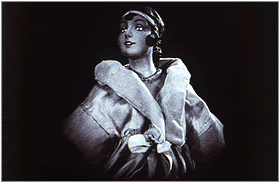
Ok, I'm not entirely sure exactly what this IS, but it looks really cool! I just learned about it in an email from longtime Darkmatters contributor Larry DeHaan, who ran across it and knows no more than what is printed on the web page: DIE GROSSE LIEBE EINER KLEINEN TÄNZERIN. The link goes to Googles translated version of a page at Das Deutsche Filminstitut, which is fairly mangled english, but somewhat understandable.
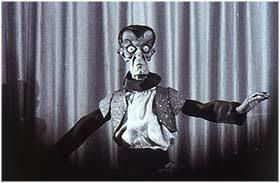
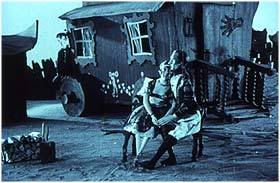

Looks really cool! My guess is it's a marionette film that's apparently based on the look of The Cabinet of Dr. Caligari, called Large Love of a Small Dancer. The puppets and sets have a great expressionist look. If any of my readers have access to a 35MM projector, there's a link at the bottom of the Filminstitute page where you can rent a print. If anybody does, I'd love to hear more about it.
Saturday, November 18, 2006
Another incredible book!

I stumbled across this one at Amazon and it sounded like something I really wanted to check out, so I ordered it and let me tell ya, I was not disappointed! I've only read the first half so far, but already I give it 5 stars. And I've read a few other books about screenplay writing and directing technique that failed to even make a decent blip on my radar. The beauty of this one is that it gives you a set of powerful tools for breaking down your movie idea into sections (and breaking those down further) so you can work out all the shots and scenes before shooting (before doing a storyboard) and find the best dramatic possibilities. It doesn't replace Writing With Pictures in terms of how to actually tell a ripping yarn, but it covers the next part of thje process, how to turn that story into a screenplay. I see them both as essential texts for any aspiring filmmaker.
He tells you how to find the NARRATIVE SPINE of your film idea, which he compares to the armature in a sculpture (something we can definitely relate to) and to use that and the FULCRUMS (dramatic turning points) to keep everything in line so you don't end up going off track somewhere. Each movement (of actor, camera or object) should relate directly to that spine, as well as to the WANTS of each character. He also discusses the GRAMMAR of film.... he compares each shot to a sentence that must contain at least one subject and one verb and he breaks scenes down into NARRATIVE BLOCKS (paragraphs) and even further into NARRATIVE BEATS (each movement is essentially a beat, and must relate to the spine of the film and to the spine of the scene). I love the way he does this.... he writes out his screenplay leaving a margin along the right edge and next to each action he jots down a verb (narrative beat). It sounds like an almost mathematical formula, but that's not the way he approaches it at all - rather it's a way of breaking things down methodically so they can be examined and correlated very specifically.
What caught my attention and made me single out this book alongside the hundreds opf other screenwriting books that litter the shelves was this subtitle: "See your film before shooting". Now you KNOW I like that! So for me this one is an integral part of the process I've been learning - of cinematic storytelling. Until finding this volume, this part of the process was pretty random for me.... just visualise the whole movie scene by scene and shot by shot and "try to make sure everything works". Well, here's an excellent process for doing exactly that! Using beats the way he does turns your screenplay into something like a poem or a song (hence the musical terminology - beats).
Wednesday, November 15, 2006
Liebcraft
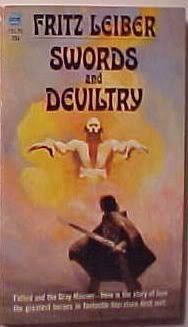
Today the book of correspondence between Lovecraft and Lieber came in and I've been immersed in it for hours. I should say Lovecraft's letters to the Liebers. It's kind of weird reading only one side of the conversations, but Lovecraft is so loquacious that he usually basically restates the original questions as he answers them. It was just so bizarre (and delightful!) to see the old master writing about Fafhrd and the Mouser! Kind of like if someone suddenly unearthed letters where leonardo Da Vinci discussed Star Wars with George Lucas (except of course that they didn't live contemporaneously). I always thought of Lieber's writing as much more recent than Lovecraft's, though that's largely because of his thorougly modern and whimsically inventive use of language, which I now know definitely was inspired by Shakespeare.
That's one of the strange things about this book for me.....
Lieber sent his (rejected by the publisher) manuscript for a story called Adept's Gambit (which from certain clues I gather is his first Faf/Mouser tale?) and Lovecraft elaborated at great length about it. Ironically, in my bedtime readings lately I'm midway through this very tale (which eventually did find publication). It's a weird one.... in that it takes place not in the fantastic and many-storied world of Nehwon but in a strange world alternately referred to as Gaia, Midgard or sometimes Earth somewhere around the Hellenistic era. I think originally that was to be the setting for the tales (shudder!) but, probably in response to some of Lovecraft's (rather excessive and nitpicking) criticisms in matters of historical accuracy and grammatical usage I'm thinking he invented the wonderful world and all its delightful locales, which are really some of the best things about the stories. Heh... Lovecraft went on for several long pages listing recommendations of historical treatises and compendiums Lieber should consult just to establish a proper sense of historical placement. Truly an extreme case of a rationalist and devoted antiquarian berating a true master of fanciful fantasy whose greatest strength is the creative weaving of locale to perfectly suit the story. It was also annoying to see him constantly attacking the use of some of Lieber's invented words and phrases (another of his strong points and a large part of what's so delightful about the F&M stories) because he feels that words should be chosen that would accurately fit the period. Interesting to see two such great artists who obviously admire each other professionally and as friends be so at odds over these trivialities, but that's the way art is.
And I now know for certain that Fafhrd was indeed based on Lieber. I couldn't be absolutely sure by Lovecraft's first hint, something along the lines (in a letter to Lieber's wife) of congratulations on having a husband so talented and possessed of such an admirable physique (could have meant he was small and in fantastic shape, like the Mouser) but later in a different letter he mentioned sending some books around to "Your Mouser" (meaning Harry Otto Fischer). They frequently mentioned sending books and manuscripts around to a small select group, which I found fascinating. In fact Lovecraft mentions a certain owner of several rare volumes who has a waiting list of people to be sent the books on loan.
I wish the letters by Lieber and his wife were included... and I wonder why they weren't? Possibly they no longer exist... apparently the Liebers kept everything Lovecraft sent them, I wonder if he just threw theirs away? I actually doubt it, especially since he obviously considered them good friends and Fritz a great talent similar in many ways to himself.
Actually, it just occurred to me..... in a recent bout of Lieber related websearching I discovered a database of a whole slew of material written by Lieber... just a listing that included manuscripts, published volumes, and letters to various friends as well as magazing articles essays and the like. Taking into consideration the fact that the book includes a goodly selection of Lovecraftian stories and articles about Lovecraft, all written by Lieber - it only makes sense that someone assembled all this material from the trove of material represented by that web database. And of course the letters sent BY the Liebers TO Lovecraft wouldn't be included in that stash. Possibly there were problems in getting permission from the current copyright holder to use letters in the possession of the Lovecraft estate. Ok, anyway... getting pretty dull here... sorry about that!
Tuesday, November 14, 2006
Yadda yadda yadda
Hmmm, well, last night I got waylaid by Federico Fellini. La Dolce Vita was on TCM, followed by a good doco on Fellini, that I had to watch. The only other Fellini film I've seen is La Strada, which I thought was absolutely brilliant. Guess I need to see the rest of his flicks.
Tonight I foamed up Cosmo's torso. More to come.
Tonight I foamed up Cosmo's torso. More to come.
Sunday, November 12, 2006
Spongehuck
Saturday, November 11, 2006
tracin spacin and erasin
All I did tonight was trace the image, and as i did I moved things around a little (Fafhrd's arm and his legs) to try to fix proportioning a little. But I screwed it up and got disgusted with it. He looks like a Frankenstein dude now. As it stands, I'm not sure I want to continue on this piece. I think it would be much better to start fresh, now that I've had a little practicce to get the rust out. Iused to be able to draw figures much better than this, and I know I'll be able to again (probably next time I try will come out a lot better).
Alas, the main reason for doing this piece was because i was burned out on my movie, but it's calling again, I think it's time to get back to those little guys and gals.
Alas, the main reason for doing this piece was because i was burned out on my movie, but it's calling again, I think it's time to get back to those little guys and gals.
Friday, November 10, 2006
For better or for worse....
Thursday, November 09, 2006
Wednesday, November 08, 2006
Craprogress
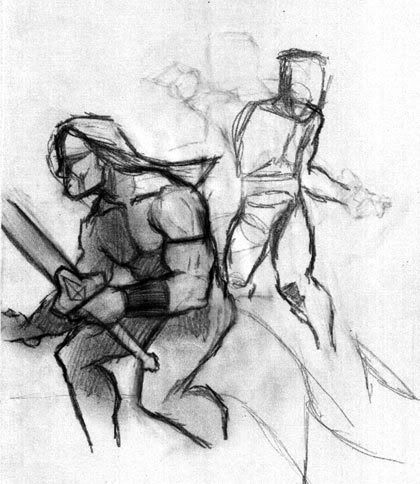
Well, I struggled, I tried, I thought, I visualized, and this is all I could come up with tonight. I think the main problem is that I don't understand the character of the Mouser (physically or personalitywise). It seems a lot harder to me to draw slender people than musclebound giants. But it's a start. Now I'll re-draw him on a fresh piece of paper, work out the pose and clothes and everything, and put them together later. I decided he would be using his sling rather than a sword, just to make it more interesting. Strange that they're both using their left arms.,... just another bit of clumsiness plaguing this piece. Maybe I'll reverse him so he's facing away from the viewer, and put the sling in his right hand.
Thought I'd post this here so it doesn't go unnoticed
Here's a comment that came in yesterday on an entry that has already slid off the first page (one of the problems with daily bloggage!). It's from Bart Van De Plas, in response to our recent discussion about Le Cid, the film with animated insects made by Beast Animation studio in Brussels:
Bart said...
"Hi,
I had a great time helping out on this film and it was very interesting seeing it all come together.
The director has a history in Theatre, and Artdirection and this was her first animation project. The storyboardpannels were real graphic pieces of art and her visual vision of the film was strong.
However; She didn't have any experiance in telling a story trough the Animation/Film medium and you can see that. Also the style of the film was to be far more dark and obscure. The project was presented to me as a feast of sex and murder, and instead it became a talking drama. The french like long dialogues, it's in their nature, and if darker the film would have been stronger and more intense.
The people at Beast Animation tried to film this project as a film, rather then as a table with some moving puppets on. I think they succeeded on this level.
They animated about 6 seconds of film a day and the whole project had a big challange to it in the sence that they had to break up the entire set in the middle of production to move it to France to shoot the second half. This had to do with split budgets in the co-production arangements. It was quite a task to do all this without damaging stuff.
I like the film, although it's a pitty the 'edge' fell of during production..."
Wow, it's great to hear from someone who worked on the production and can answer these questions! Thanks for explaining how it all came together.
Bart said...
"Hi,
I had a great time helping out on this film and it was very interesting seeing it all come together.
The director has a history in Theatre, and Artdirection and this was her first animation project. The storyboardpannels were real graphic pieces of art and her visual vision of the film was strong.
However; She didn't have any experiance in telling a story trough the Animation/Film medium and you can see that. Also the style of the film was to be far more dark and obscure. The project was presented to me as a feast of sex and murder, and instead it became a talking drama. The french like long dialogues, it's in their nature, and if darker the film would have been stronger and more intense.
The people at Beast Animation tried to film this project as a film, rather then as a table with some moving puppets on. I think they succeeded on this level.
They animated about 6 seconds of film a day and the whole project had a big challange to it in the sence that they had to break up the entire set in the middle of production to move it to France to shoot the second half. This had to do with split budgets in the co-production arangements. It was quite a task to do all this without damaging stuff.
I like the film, although it's a pitty the 'edge' fell of during production..."
Wow, it's great to hear from someone who worked on the production and can answer these questions! Thanks for explaining how it all came together.
Tuesday, November 07, 2006
1st attempt at a composition for a painting.

Ok, enough with copying photographs! It's time to start drawing entirely from the depths of my mind. That's how I'll need to do it for the paintings, unless I plan to hire models to pose (and heck with THAT!). Here I'm going for an older, brawnier Fafhrd, as opposed to the strapping youth version I drew earlier. I left space for the Mouser to stand next to him, back to back, facing danger with blades drawn and nerves of steel. The pose looks kind of clumsy, but after living with this drawing for a little while I'll re-do it in a slightly modified pose. That's how I had to do the Longbow painting I did of him that's on my site.... I couldn't do the foreshortening for the rather difficult pose until I first drew it looking straight atr him (no foreshortening). That done, I found it simple to translate the pose into three dimentsional space with depth and everything.
Oh, and yes, I'm well aware he has no midsection! His ribcage seems to sit right on his pelvis! I'll be fixing that too.
Monday, November 06, 2006
Sketchin' wit the Fafmeister
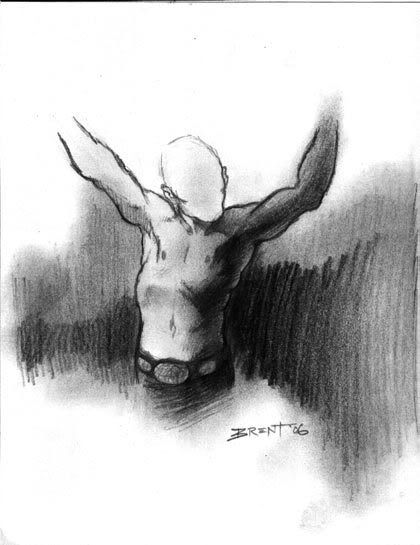
Tonight's progress. I'm just trying to get my rusty skills back in shape. This is from photoreference of my mystery celeb (who is the visual inspiration for Fafhrd). It came out a bit clumsy, but I definitely feel that toward the end of the drawing I was getting better. I wasn't worried about fussy little details like hands and face, more the basic forms of the body itself. I want to do a few more sketches like this to get the ol' skills dusted off, then do a bunch of gestural sketches to try to figure out poses I might want to base a painting on.
The poor barbarian! His chest is all messed up! That's me trying to exaggerate beyond my ability to do so.
A part of my goal I didn't mention in that long rambling post below.... when I'm done with the Frazetta/Jones emulation phase, I hope to move beyond, into more expressionistic work, to push myself into my own territory. In other words, think of this as my Renaissance, and it will serve as the basis for my further development toward my own painting style.
Also, these paintings are helping me deal with multiple figures interacting wth each other in a defined environment, in the context of a good composition. Total stopmo stuff!
Ok, I need to just quit with the ramblin'! See, it's like I always say... artists do what they do BECAUSE they have something to express that can't be expressed in daily conversation. If I could say it, I wouldn't need to be an artist. See?
Sunday, November 05, 2006
Where I'm going
Sven made me realize that I haven't really explained why I'm doing the Fafhrd painting project, so I thought I'd try to give it a shot here.
To start with, there are 3 things I've always wanted to be able to do when I grow up.... stopmotion, sculpture, and oil painting. And like the Bauhaus artists, I believe each form of art strengthens the others... in other words, what I learn about sculpture helps me in my animation AND my painting, etc. I've been drawing for as long as I can remember, and got serious about it in the beginning of the '90's when I took art classes at the local community college. I gotta say though, I learned a lot more on my own than I did in class. The classroom environment was nice because i was surrounded by other art students and encouraged to push myself, and just having assignments that needed to be finished on time makes you work. But most of the learning I did there (aside from some good art philosophy I absorbed from my instructor Dale Threlkeld) was on my own, after class, in the library. I also bought myself a bookcase that I nicknamed the U of Me (or the University of Myself) and started filling with books. That actually was a fairly comprehensive university (the U of Me that is) with a curriculum in the Humanities.... literature, psychology, philosophy, a little poetry, as well as art instruction.
In art my main focus was always on the human figure. For time I wanted to be a comic book artist in fact. I've bought (and studied) a lot of anatomy books, my favorites being the Burne Hogarth Dynamic Anatomy series and the Robert Beverly Hale books, which are the most advanced anatomy books I've been able to find. I believe the human figure is the measure of all things, at least in our humancentric world. Studying anatomy and figure drawing is the way to develop your artistic skills and to guage your progress. The reason I say this is... obviously anybody can sling paint around and say "I'm an abstract artist".... but where's the skill? Where's the knowledge? I was doing that with fingerpaints when I was 3! I believe to call youirself an artist you need to have some skills. And in art, the human figure is probably the most difficult thing there is, and at the same time the most recognizable. We all know what people look like, so we can tell if they're painted 'right' or not. And I'm not referring only to photorealism here.... personally I prefer art with some degree of distortion and expressionism. But before you start to distort or get expressive, it pays to do your homework (which is learning anatomy as well as you can). In learning to paint (or draw or sculpt) the human figure you learn all you need to know to do anything else.... the subtlety, the color control, the balance of large smooth curves coordinated against complex forms..... the dynamic tension of a body in athletic action and the expressiveness of a face. It takes a long time and a lot of learnin' to get good at it, and by the time you are, you can call yourself an artist. The skills you develop along the way will apply even if you're just painting park benches or abstract designs.
Ok, so much for my philosophy of art. Now on to the particulars of what I hope to accomplish in the near future. I've done SOME painting in the past... a little watercolor, and I've dabbled in oils and acrylics and casiens and gouaches and a few other things. But I wouldn't say I'm good at any of them yet. I've always used drawing media in the past, which handle differently, and I guess that's what I'm used to. With a pencil, if you want something darker you press harder... simple as pie. It doesn't work that way in painting. If you want an area darker you have to use darker paint, and then you're delving into the whole area of color theory, as well as brush handling (brush strokes are very different from pencil strokes) and the whole slew of problems associated with the physical and chemical properties of the various paints. Some are thick like frosting or toothpaste, some are very runny, some are more transparent or opaque than others, some will have weird reactions with certain other pigments... it's a lot to deal with. And as if that's not ENOUGH..... what kind of painting technique to use? They udon't teach technique in schools anymore, except at certain very select private ateliers and possibly some of the most expensive art schools. When I was in painting class the teacher just walked through all the time saying "you learn to paint by painting". This is apparenty the legacy of Postmodern Art, in which it's been declared that "painting is dead" and all that counts is finding innovative new ways to shock an audience (that generally involve no skill whatsoever, like immersing a plastic crucifix in a jar of urine). I was actually pretty pissed off that, after spending so much money on tuition, I wasn't taught a damn thing about how to paint! I mean geeze.... I could have "learned to paint by painting" at home!
Well, so I bought books on painting techniques. Impressionist, post-expressionist, baroque, renaissance, etc. etc. ad infinitum. They all have their own theories and approaches. I've tried a few of them and haven't found an approach that seems straightforward and intuitive enough to me yet. I couldn't understand what to do with the pencil drawing on the canvas... do you try to hide it completely, let it show through, or what? Do you paint opaquely, transparently, a little of both? What? Paint thick, paint thin..... I was so confused!!!
So I decided to get back to basics.... to try to paint in a 'classical' style (rather than some expressionist technique). At one time Kent Williams painted very much like Jeffrey Jones, who was his mentor. So I figure, why not start out by learning to paint like the classic '60s and '70s fantasy artists I grew up with? Frazetta and Jeff Jones being my favorites. Then from there I have a solid basis to branch off from into more experimental territory. In emulating artists like Frazetta and Jones I learn about composition, multiple figures interacting in a solid environment, anatomy, powerful colors, the whole nine yards!
And then the Bud Plant catalog came in a few weeks ago and I saw a DVD called The Secrets of Fantasy Painting by Mike Hoffman. This guy paints a lot like Frazetta (some say too much like him) but that's perfect! Exactly what I was looking for in fact. And watching somebody actuially paint on a DVD is a lot more informative than seeing pictures in a book. You can see exactly how he moves the brush, how fast he works, how careful he is, etc.
Ok, this has gone on long enough. I could go on and on, but I wouldn't be saying anything important, so it's time to stop now.
To start with, there are 3 things I've always wanted to be able to do when I grow up.... stopmotion, sculpture, and oil painting. And like the Bauhaus artists, I believe each form of art strengthens the others... in other words, what I learn about sculpture helps me in my animation AND my painting, etc. I've been drawing for as long as I can remember, and got serious about it in the beginning of the '90's when I took art classes at the local community college. I gotta say though, I learned a lot more on my own than I did in class. The classroom environment was nice because i was surrounded by other art students and encouraged to push myself, and just having assignments that needed to be finished on time makes you work. But most of the learning I did there (aside from some good art philosophy I absorbed from my instructor Dale Threlkeld) was on my own, after class, in the library. I also bought myself a bookcase that I nicknamed the U of Me (or the University of Myself) and started filling with books. That actually was a fairly comprehensive university (the U of Me that is) with a curriculum in the Humanities.... literature, psychology, philosophy, a little poetry, as well as art instruction.
In art my main focus was always on the human figure. For time I wanted to be a comic book artist in fact. I've bought (and studied) a lot of anatomy books, my favorites being the Burne Hogarth Dynamic Anatomy series and the Robert Beverly Hale books, which are the most advanced anatomy books I've been able to find. I believe the human figure is the measure of all things, at least in our humancentric world. Studying anatomy and figure drawing is the way to develop your artistic skills and to guage your progress. The reason I say this is... obviously anybody can sling paint around and say "I'm an abstract artist".... but where's the skill? Where's the knowledge? I was doing that with fingerpaints when I was 3! I believe to call youirself an artist you need to have some skills. And in art, the human figure is probably the most difficult thing there is, and at the same time the most recognizable. We all know what people look like, so we can tell if they're painted 'right' or not. And I'm not referring only to photorealism here.... personally I prefer art with some degree of distortion and expressionism. But before you start to distort or get expressive, it pays to do your homework (which is learning anatomy as well as you can). In learning to paint (or draw or sculpt) the human figure you learn all you need to know to do anything else.... the subtlety, the color control, the balance of large smooth curves coordinated against complex forms..... the dynamic tension of a body in athletic action and the expressiveness of a face. It takes a long time and a lot of learnin' to get good at it, and by the time you are, you can call yourself an artist. The skills you develop along the way will apply even if you're just painting park benches or abstract designs.
Ok, so much for my philosophy of art. Now on to the particulars of what I hope to accomplish in the near future. I've done SOME painting in the past... a little watercolor, and I've dabbled in oils and acrylics and casiens and gouaches and a few other things. But I wouldn't say I'm good at any of them yet. I've always used drawing media in the past, which handle differently, and I guess that's what I'm used to. With a pencil, if you want something darker you press harder... simple as pie. It doesn't work that way in painting. If you want an area darker you have to use darker paint, and then you're delving into the whole area of color theory, as well as brush handling (brush strokes are very different from pencil strokes) and the whole slew of problems associated with the physical and chemical properties of the various paints. Some are thick like frosting or toothpaste, some are very runny, some are more transparent or opaque than others, some will have weird reactions with certain other pigments... it's a lot to deal with. And as if that's not ENOUGH..... what kind of painting technique to use? They udon't teach technique in schools anymore, except at certain very select private ateliers and possibly some of the most expensive art schools. When I was in painting class the teacher just walked through all the time saying "you learn to paint by painting". This is apparenty the legacy of Postmodern Art, in which it's been declared that "painting is dead" and all that counts is finding innovative new ways to shock an audience (that generally involve no skill whatsoever, like immersing a plastic crucifix in a jar of urine). I was actually pretty pissed off that, after spending so much money on tuition, I wasn't taught a damn thing about how to paint! I mean geeze.... I could have "learned to paint by painting" at home!
Well, so I bought books on painting techniques. Impressionist, post-expressionist, baroque, renaissance, etc. etc. ad infinitum. They all have their own theories and approaches. I've tried a few of them and haven't found an approach that seems straightforward and intuitive enough to me yet. I couldn't understand what to do with the pencil drawing on the canvas... do you try to hide it completely, let it show through, or what? Do you paint opaquely, transparently, a little of both? What? Paint thick, paint thin..... I was so confused!!!
So I decided to get back to basics.... to try to paint in a 'classical' style (rather than some expressionist technique). At one time Kent Williams painted very much like Jeffrey Jones, who was his mentor. So I figure, why not start out by learning to paint like the classic '60s and '70s fantasy artists I grew up with? Frazetta and Jeff Jones being my favorites. Then from there I have a solid basis to branch off from into more experimental territory. In emulating artists like Frazetta and Jones I learn about composition, multiple figures interacting in a solid environment, anatomy, powerful colors, the whole nine yards!
And then the Bud Plant catalog came in a few weeks ago and I saw a DVD called The Secrets of Fantasy Painting by Mike Hoffman. This guy paints a lot like Frazetta (some say too much like him) but that's perfect! Exactly what I was looking for in fact. And watching somebody actuially paint on a DVD is a lot more informative than seeing pictures in a book. You can see exactly how he moves the brush, how fast he works, how careful he is, etc.
Ok, this has gone on long enough. I could go on and on, but I wouldn't be saying anything important, so it's time to stop now.
Here we go again.... SuperNOVembathon!!!!
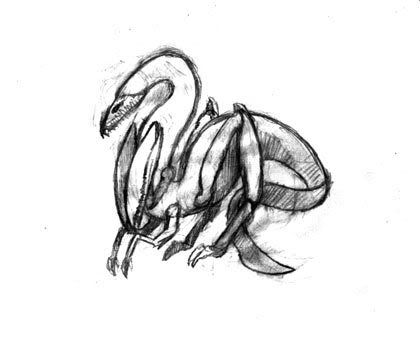
With Monster Month behind us now, we've decided to start another production marathon because basically Shelley and I were both slackin'. I'll be jumping back and forth between a few different projects... one being the Fafhrd painting project (which nobody seems to dig much), one being the Scott Radke puppet flick (which I was getting burnt on so I had to do something else for a little while) and then there's the critter above, which I'm designing and hope to build as a stopmo puppet and animate sometime next year. He's the Dragontiss (emphasis on the second syllable), and you can see more details about him on our Monster Month page at Flickr.
Friday, November 03, 2006
Fritz Lieber - the Shakespeare of fantasy fiction?

One of the fantastic Jeff Jones covers.
I decided to go back and (oce again) re-read some of the Fafhrd and the Grey Mouser stories to familiarize myself with the characters before setting off to illustrate them. The books are actually collections of short stories (except for Swords Against Lankhmar, which is a full length novel) that were originally written for pulp magazines.... some of the same ones that published stories by Robert E Howard and Lovecraft. In fact, though Lieber began his writing career pretty much at the time Lovecraft was ending his, they struck up a correspondence that lasted many years (begun by Lieber's wife who knew how much he like Lovecraf'ts stories and just wrote to him out of the blue). I learned this and much more over the last couple of days through extensive research (thanks Google!). I also just ordered a book of their correspondence and some of Lieber's Lovecraftian stories, which I'm looking forward to immensely. Following are a few more choice tidbits of Lieber lore:
The characters Fafhrd and the Grey Mouser were actually based on himself and his friend author Harry Otto Fischer, who wrote 10,000 words of The Lords of Quarmall (which was possibly the first written of the tales? Not sure). The rest was penned by Lieber. I haven't been able to determine which author inspired which character (I thought a peek at them would help me figure out what the Mouser should look like) and I haven't found a pic of Fischer yet, but I did find one tiny image of Lieber as a very old man (looking a bit like Tolkien). He seems even at that advanced age to be a pretty large fellow, so I'm thinking Fafhrd. In fact, I suspect it's true from the handling of them in the stories... Fafhrd is more sympathetically presented and more fully developed.
The first pair of stories chronologically (according to the fictional timeline, not when they were written) is a solo Fafhrd tale, about his life amid the frozen northern wilderness and the small community there, and the second is the Mouser's intro, and in the third story they meet and forge a lifelong bond. Fafhrd's intro is some of the most excellent fiction I've ever read (and I don't say that lightly). Lieber's prose is lyrical and almost poetic, if sometimes a bit flowery, but in a playful inventive way that I find amusing and powerfully imaginative at the same time. That's why I compare him to Shakespeare..... none of the other author's I've read (and that's quite a few) can weave a sentence as inventive, as delightful, and as descriptive as he can. In my web research I ran across countless similar sentiments posted by some of his admiring fans.
I remember some time ago when I was really into watching classic black and white films on TCM (not that I'm not still into that) I was dumbstruck by the beautiful imagery of Charles Laughton's Hunchback of Notre Dame, and also thunderstruck to see the name Fritz Lieber in the credits! Turns out it's his dad. The old coot was a silent film star and Shakespearian stage actor. That might explain a few things.
What really smacked me between the eyes this go-around is the sheer storytelling skill! I was aware when I read the stories in my younger days that there were things going on that I was unaware of, compelling powerful things that made me keep coming back for more and made it impossible to close the book, but I didn't know what it was. Now it's clear as day to me.... it's good old simple straightforward storytelling! I was in awe seeing how deftly he weaves things together - example:
Fafhrd's mother is the leader of the Snow Women, who are all rumored to have witchy control over elements of cold and to use it to keep their men in line. At certain key moments some of the men would suddenly become subject to an icy chill in the blood, or in the loins. The Show has just come to town, a sort of traveling burlesque act from the decadent southern cities featuring half naked (or in some instances stark naked) girls (characterized as "scrawny" by the Nordic women). All the men are going to the show, and all the women are up in arms about it, gathered in one big tent from which issue flickering candlelight, occasional flashes of strange colored light, odd smells, and a constant low murmering chanting sound. It's become unseasonably cold, and just keeps getting colder, as ice crystals of unnatural size begin to form over every surface, but especially the hide covering of the tent housing The Show, which creaks and bulges inward under the unaccustomed and ever-increasing weight. Each segment of the story alludes at some point to the ice crystals, always reminding the reader of that growing threat. And as the story progresses, the landscape itself seems to gradually transform, becoming an icy hell making the mere act of walking treacherous and dangerous. Each time Fafhrd tries to accomplish something he's thwarted (or almost thwarted) by huge heaps of snow falling from unseen branches high overhead, or by an avalanche at one point, and toward the end of the story monstrous ice appartitions, like titanic statues begin to take form, moaning and creaking in the wind, which makes them sway almost as if they're about to break free and step forward. Or simply fall forward, crushing him under their sheer weight. It's masterul writing.... each time he alludes to the growing threat of the ice, it reminds the reader of the women chanting away in their tent, maybe or maybe not actually controlling the weather. It creates a sense of the menace constantly growing throughout the story, and ties "magic" (which in his world might exist, or might be just superstitious dread strained to the breaking point by odd circumstances) in with real human motivations (jealousy etc). It gives a human element to stories that in other hands would be inhuman.
Subscribe to:
Posts (Atom)

